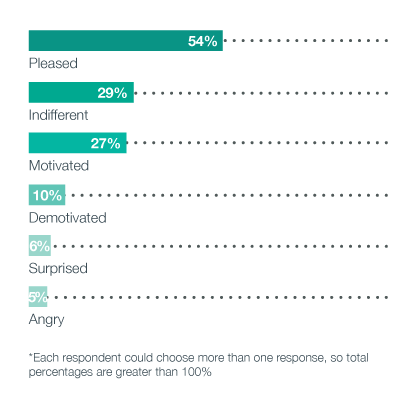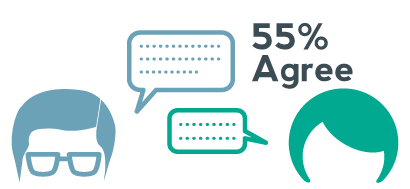Report
The annual performance review: Old-school or timeless tool?

A corporate trend away from annual performance reviews has been making headlines lately, leaving business leaders second-guessing their companies’ performance management programs. While those who’ve eliminated them claim that formal performance reviews are too costly, overly time-consuming, and a hindrance to productivity, we at Eagle Hill believe there’s more to this decision than just the company’s bottom line. Informed by our nationwide survey on employees’ views of the annual performance review, we recommend five questions a company must ask when considering whether to save it or scrap it.
A recent Eagle Hill nationwide survey of more than 1,600 professionals across a range of industries and career levels reveals there’s not yet across-the-board consensus on the value of conducting annual performance reviews. While you may guess that employees are against the feedback process, this isn’t necessarily the case. Only half of the U.S. workers we polled think it’s a good idea to eliminate the formal system, leaving another half that isn’t so sure.
To provide context, we also asked respondents not only their feelings about their last performance review but also about the culture of feedback within their organizations, the perceived role of annual reviews, and the link between reviews and compensation. We’ve identified five key questions companies must consider when evaluating their programs to determine if a change is warranted.
Question 1: How does your organization use performance reviews?
In our human capital work at Eagle Hill, we’ve found that annual performance reviews have become so rote that, in many companies, management forgets to periodically assess the reasons for conducting them. In our survey, we asked employees how performance reviews are used in their organizations. The most common uses selected are to benchmark accomplishments over the past year (78 percent), to make sure managers and employees are on the same track in terms of goals and priorities (77 percent), and to set goals for the following year (70 percent).
Fewer employees said that reviews are used to document their performance as it relates to their next promotion (49 percent) or to provide a set of actionable career development activities (62 percent).
FIGURE 1: MY ANNUAL PERFORMANCE REVIEW IS CONDUCTED IN ORDER TO:

This data suggests that companies are focusing on documenting past performance and goal-setting, but falling short on the follow-through. Especially if your review process is only providing a “backward” view into performance, it’s probably a good idea to redirect time and resources toward helping people translate feedback into actionable areas for growth. Whether this is best accomplished through reforming or replacing the existing review process is dependent on your organization’s culture, but whatever path you choose, the biggest return on investment from performance management programs comes from future gain, not past reflection.
Question 2: How do your employees feel about your existing performance review process?
The good news: According to our research, a majority of respondents (54 percent) were pleased with their last performance review and only small percentages felt demotivated (10 percent), surprised (six percent), or angry (five percent). However, only about a third of respondents (27 percent) were motivated by the feedback they received, and another third (29 percent) were left feeling indifferent (Figure 2).
These findings further support the need for actionable outcomes from performance reviews; this is especially important because an organization’s highest performers are usually those who feel engaged and motivated. Investing in an effort to understand how your current review process is received by your employees—say through an employee survey or focus groups—can offer valuable information for improving your system. Whether you find you’re doing great (congratulations!) or uncover some unintended negative consequences, the investment in understanding the employee viewpoint provides a valuable baseline upon which to design a positive performance review system for today and well into the future.
FIGURE 2: AFTER MY LAST PERFORMANCE REVIEW DISCUSSION, I FELT:*

Question 3: Does your organization have a culture of providing feedback?
If your organization is seriously considering retiring formal annual performance reviews, the obvious next step is to figure out what will take their place. A common approach is to transition to a system that employs more frequent feedback sessions, whether formal, informal, or a combination of both.
In our survey, just a little over half of respondents (55 percent) said they currently receive regular feedback on their performance from supervisors. And when asked whether they thought it was a good idea to replace annual performance reviews with a system of regularized feedback, only 49 percent agreed, with those who felt that their last performance review was accurate slightly more inclined to want to keep the annual review (Figure 3).
So in deciding your approach, a critical question is whether your organization currently has a culture that encourages and expects regular feedback. If not, the elimination of formal reviews may be too much to undertake. Instead, work on developing the informal feedback culture first so that an eventual transition will be more natural and seamless.
FIGURE 3: DO YOU AGREE WITH THE FOLLOWING STATEMENTS?
My manager provides regular informal feedback on my job performance.

It’s a good idea to eliminate annual performance reviews and replace them with a system of regular feedback from supervisors.

Question 4: How does the size of your organization impact performance management?
So who does want regular feedback instead of an annual review? We found that employees of large or very large organizations were almost twice as likely as those who work for small- to mid-size firms to prefer feedback (Figure 4).
This finding suggests that organizations should carefully evaluate not only the perceived value of their performance management systems to employees but also the amount of time it requires of them. If the system is seen as overly burdensome to the point of affecting productivity, or if it is not meeting the growth and development needs of your employees, it may be time to consider an overhaul.
FIGURE 4: WOULD YOU PREFER TO RECEIVE REGULAR PERFORMANCE FEEDBACK OVER ONE ANNUAL PERFORMANCE REVIEW?

Question 5: Is compensation linked to performance reviews? Should it be?
A common use of performance reviews is to provide a key input for determining how to allocate limited financial resources among employees. According to our study:
65% believe their last performance review was an accurate reflection of their performance
43% of respondents are confident that salaries and/or bonuses can be fairly determined without a formal annual review
These two findings indicate that performance review programs are generally working and that the majority of employees are wary of eliminating formal reviews.
This is not to say that companies should never transition to an informal performance review process. Rather, organizations considering it must (a) do their due diligence in soliciting employees’ perspectives on the process and (b) be very clear on exactly how performance review information will be used (or not) to make financial decisions.
At the end of the day, your people are your biggest and most worthwhile investment. Having a performance management approach in place that helps employees navigate and enhance their careers is critical. You must have an established system that gives your people an opportunity to discuss their areas of achievement as well as those in which they need improvement or seek growth. What that process should look like depends upon your company’s unique culture and the needs and preferences of your employees. Taking a pulse of the culture and asking your team how they feel about the value provided by your company’s annual performance review process—versus making uninformed judgments for them—will ensure a successful system that will ultimately boost your people’s careers as well as your organization’s bottom line.

